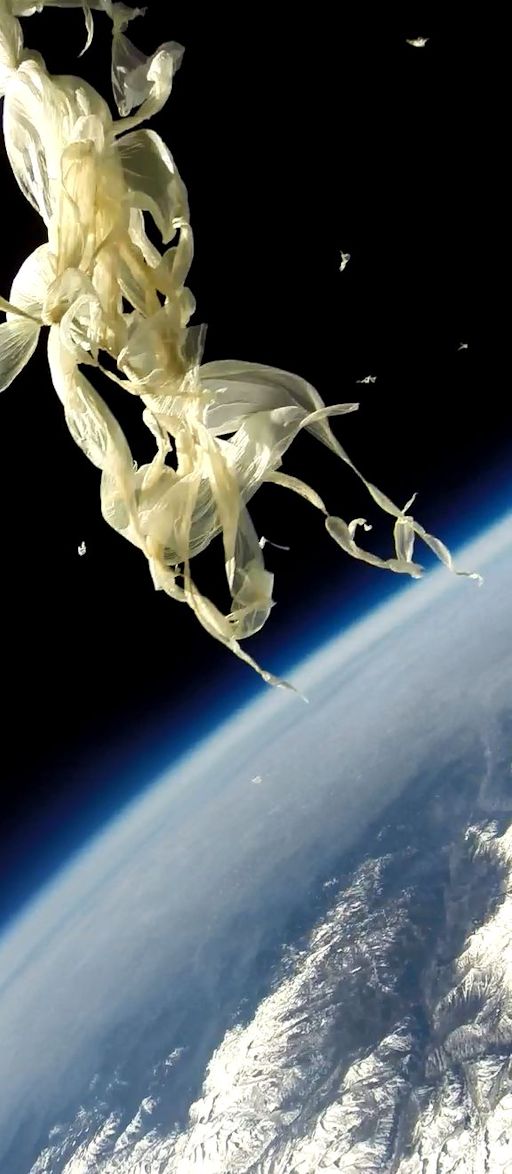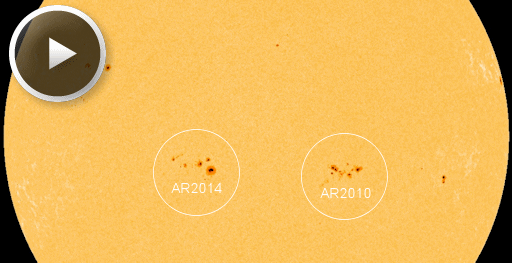When is the best time to see auroras? Where is the best place to go? And how do you photograph them? These questions and more are answered in a new book, Northern Lights - a Guide, by Pal Brekke & Fredrik Broms. | | | CME IMPACT: A CME hit Earth's magnetic field on March 25th at approximately 19:45 UT (12:45 pm PDT). Minor to moderate geomagnetic storms are possible in the hours ahead. High-latitude sky watchers should be alert for auroras after nightfall. Aurora alerts: text, voice OBJECT AT THE EDGE OF SPACE: On March 16th, a strangely-shaped object was photographed 92,000 feet above Earth's surface. Can you guess what it is? Scrutinize the image, then scroll down for the answer: 
It's a tangled wad of natural rubber, the remains of a suborbital helium research balloon that popped approximately 2 seconds before the photo was taken. Regular readers might have already guessed that the picture was taken by the Space Weather Rapid Response (SWxRR) Payload launched to the stratosphere on March 16th by the students of Earth to Sky Calculus. This is just one of many spectacular pictures captured during the two-hour flight to the edge of space. SWxRR is an experimental payload that can be launched to the edge of space with minimal delay in response to fast-developing or unexpected space weather events. It contains cameras, a cryogenic thermometer, a GPS altimeter, and a 10.0 KeV to 20.0 MeV radiation counter to measure the effect of solar storms on Earth's upper atmosphere. Ultimately, as techniques are improved, we hope to be able to sample the radiation content of the atmosphere and report results to readers while storms are in progress. Data from the March 16th flight are being analyzed now. Stay tuned for updates. Realtime Space Weather Photo Gallery ACTIVE SUNSPOTS: Earth is looking down the double barrel of two potentially active sunspots: AR2010 and AR2014 have complex magnetic fields that harbor energy for strong eruptions, and both have grown since the week began. Click to view a movie of their development from NASA's Solar Dynamics Observatory: 
The CME expected to sideswipe Earth later today was propelled toward us by a C-flare from sunspot AR2014 on March 23rd. Otherwise the two sunspots have been mostly quiet. Is it the calm before the storm? NOAA forecasters estimate a 45% chance of M-class flares and a 5% chance of X-flares on March 25th.. Solar flare alerts: text, voice Realtime Aurora Photo Gallery
Realtime Mars Photo Gallery
Realtime Comet Photo Gallery
Every night, a network of NASA all-sky cameras scans the skies above the United States for meteoritic fireballs. Automated software maintained by NASA's Meteoroid Environment Office calculates their orbits, velocity, penetration depth in Earth's atmosphere and many other characteristics. Daily results are presented here on Spaceweather.com. On Mar. 22, 2014, the network reported 2 fireballs.
(2 sporadics) 
In this diagram of the inner solar system, all of the fireball orbits intersect at a single point--Earth. The orbits are color-coded by velocity, from slow (red) to fast (blue). [Larger image] [movies]
Potentially Hazardous Asteroids ( PHAs) are space rocks larger than approximately 100m that can come closer to Earth than 0.05 AU. None of the known PHAs is on a collision course with our planet, although astronomers are finding new ones all the time. On March 25, 2014 there were 1462 potentially hazardous asteroids. Notes: LD means "Lunar Distance." 1 LD = 384,401 km, the distance between Earth and the Moon. 1 LD also equals 0.00256 AU. MAG is the visual magnitude of the asteroid on the date of closest approach. | | The official U.S. government space weather bureau | | | The first place to look for information about sundogs, pillars, rainbows and related phenomena. | | | Researchers call it a "Hubble for the sun." SDO is the most advanced solar observatory ever. | | | 3D views of the sun from NASA's Solar and Terrestrial Relations Observatory | | | Realtime and archival images of the Sun from SOHO. | | | from the NOAA Space Environment Center | | | the underlying science of space weather | | 
